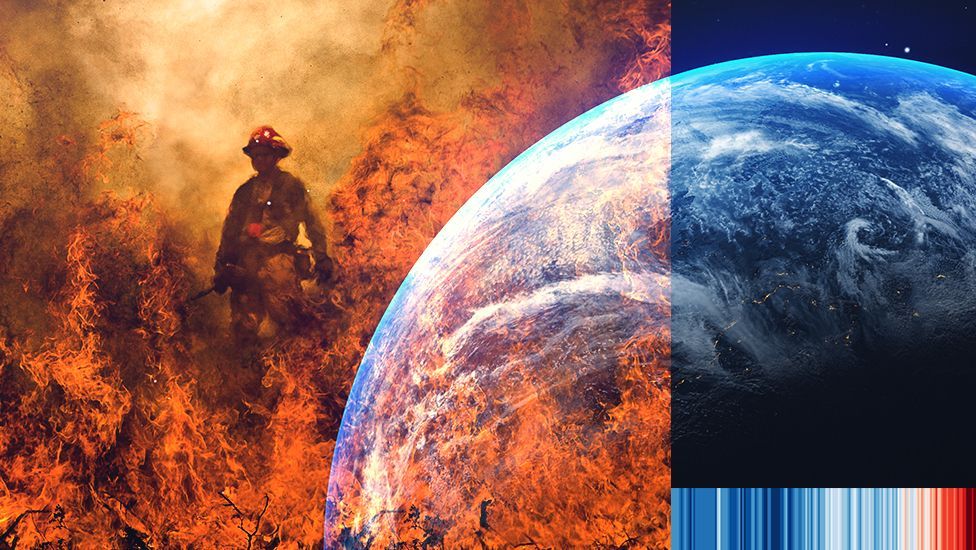July 9, 2024: The second annual Indicators of Global Climate Change report, which is led by the University of Leeds, reveals that human-induced warming has risen to 1.19°C over the past decade (2014-2023) – an increase from the 1.14°C seen in 2013-2022 (set out in last year’s report). Looking at 2023 in isolation, warming caused by human activity reached 1.3°C. This is lower than the total amount of warming we experienced in 2023 (1.43°C), indicating that natural climate variability, in particular El Niño, also played a role in 2023’s record temperatures.
The analysis also shows that the remaining carbon budget - how much carbon dioxide can be emitted before committing us to 1.5°C of global warming - is only around 200 gigatonnes (billion tonnes), around five years' worth of current emissions. In 2020, the Intergovernmental Panel on Climate Change (IPCC) calculated the remaining carbon budget for 1.5°C was in the 300 to 900 gigatonnes of carbon dioxide range, with a central estimate of 500. Since then, CO2 emissions and global warming have continued. At the start of 2024, the remaining carbon budget for 1.5°C stood at 100 to 450 gigatonnes, with a central estimate of 200.
The Indicators of Global Climate Change Project is being coordinated by Professor Piers Forster, Professor of Climate Physics University of Leeds. He said: “Our analysis shows that the level of global warming caused by human action has continued to increase over the past year, even though climate action has slowed the rise in greenhouse gas emissions. Global temperatures are still heading in the wrong direction and faster than ever before. Our analysis is designed to track the long-term trends caused by human activities. Observed temperatures are a product of this long-term trend modulated by shorter-term natural variations. Last year, when observed temperature records were broken, these natural factors were temporarily adding around 10% to the long-term warming.”
The warning comes as climate experts meet in Bonn to prepare the ground for the COP29 climate conference which takes place in November in Baku, Azerbaijan.
The authoritative source of scientific information on the state of the climate is the UN’s Intergovernmental Panel on Climate Change (IPCC), but as its next major assessment will not happen until around 2027, this creates an “information gap”, particularly when climate indicators are changing rapidly.
The new report is accompanied by an open data, open science platform – the Climate Change Tracker’s Indicators of Global Climate Change dashboard which provides easy access to updated information on the key climate indicators.
The latest Indicator report, which is published by more than 50 scientists in the journal Earth System Science Data, also provides new insight into the effects of reductions in sulphur emissions from the global shipping industry. The sulphur has a cooling effect on the climate by directly reflecting sunlight back to space and by helping more reflective clouds to form, but ongoing reductions in those emissions have lessened that effect.
Although this was offset last year by the aerosol emissions from the Canadian wildfires, the report says the longer-term trend nonetheless indicates that the amount of cooling we can expect from aerosol emissions is continuing to decline.
Other key findings:
- Human-induced warming has risen to 1.19°C over the past decade (2014-2023) – an increase from the 1.14°C seen in 2013-2022 (set out in last year’s report).
- Human-induced warming has been increasing at a rate that is unprecedented in the instrumental record, reaching roughly 0.26°C per decade over 2014-2023.
- This high rate of warming is caused by a combination of greenhouse gas emissions being consistently high, equivalent to 53 billion tonnes of CO2 per year, as well as ongoing improvements in air quality, which are reducing the strength of human-caused cooling from particles in the atmosphere.
- High GHG emission levels are also affecting the Earth's energy balance: ocean buoys and satellites are tracking unprecedented flows of heat into the Earth’s oceans, ice caps, soils and atmosphere. This flow of heat is 50% higher than its long-term average.
Professor Piers Forster, Professor of Climate Physics, University of Leeds added: “Fossil fuel emissions are around 70% of all GHG emissions and clearly the main driver of climate change, but other sources of pollution from cement production, farming and deforestation and cuts to the level of sulphur emissions are also contributing to warming. Rapidly reducing emissions of greenhouse gases towards net zero will limit the level of global warming we ultimately experience. At the same time, we need to build more resilient societies. The devastation wrought by wildfires, drought, flooding and heat waves the world saw in 2023 must not become the new normal.”
It is hoped that the report will play a strong role in informing new Nationally Determined Contributions, the improved climate plans that every country in the world has promised to put forward to the United Nations Framework Convention on Climate Change (UNFCCC) by 2025 to cut emissions and adapt to climate impacts.

 Global warming caused by humans is advancing at 0.26°C per decade – the highest rate since records began, according to new research by more than 50 leading international scientists.
Global warming caused by humans is advancing at 0.26°C per decade – the highest rate since records began, according to new research by more than 50 leading international scientists.










.jpeg)

















.jpg)


